What Causes Stress in the Workplace? Understanding and Managing the Drivers
Last Updated Nov 7, 2025

Your team looks fine on paper. But behind the scenes? Deadlines get missed. Slack messages go unanswered. Lunch breaks disappear. And more people seem “off” than on.
This isn’t a motivation problem. It’s stress — and it’s everywhere.
Whether it’s crushing workloads, unclear expectations, or micromanagement that strangles creativity, stress doesn’t just wear people down. It chips away at morale, focus, and ultimately, your company’s bottom line. Employees stop innovating and start surviving. And when pressure becomes chronic, even top performers check out.
But stress doesn’t have to run the show.
HR leaders have more influence than ever to create workplaces where employees feel calm, clear, and in control. From spotting the early red flags to investing in smarter, culture-driven solutions, there are proven ways to flip the script on burnout.
Uncover the hidden drivers of stress — and how to stop them before they derail your team.
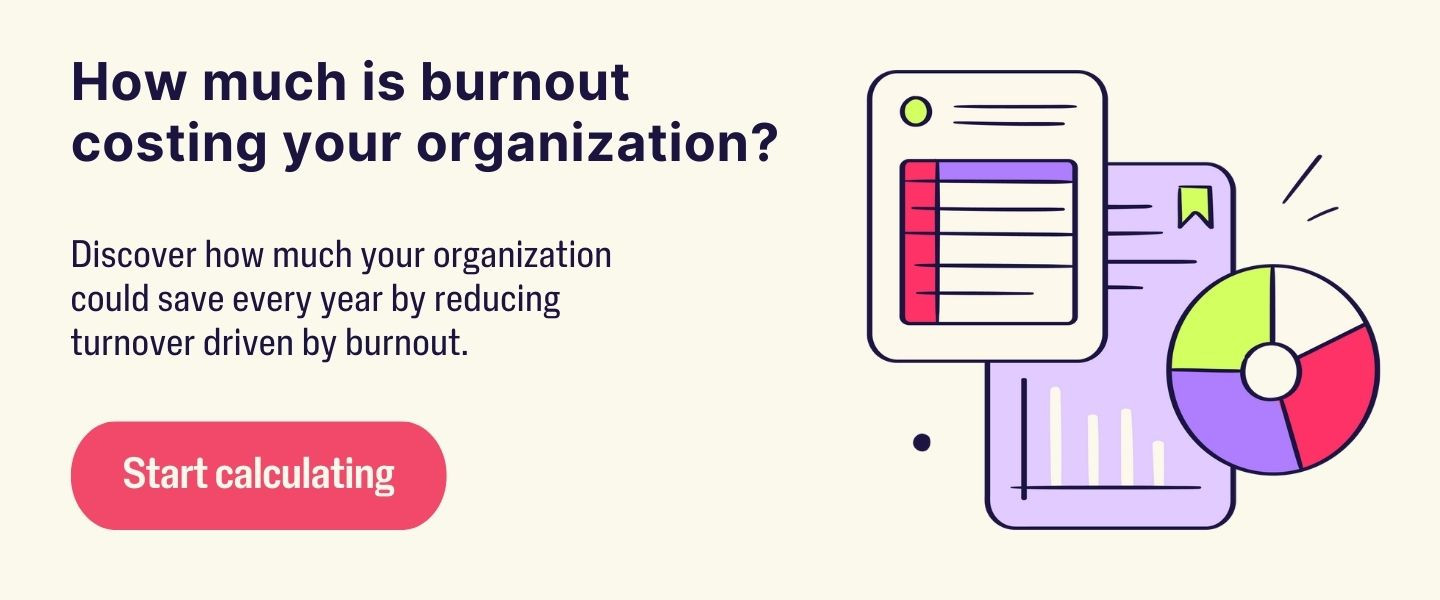
What You’ll Learn
- The leading causes of workplace stress include unrealistic workloads, lack of autonomy, poor communication, toxic cultures, job insecurity, and poor work-life wellness.
- Stress can be both positive (eustress) and negative (distress), but chronic negative stress harms wellbeing, productivity, and retention.
- Workplace stress directly impacts business outcomes, driving higher absenteeism, presenteeism, turnover, healthcare costs, and reduced customer satisfaction.
- Common warning signs in employees include declining performance, irritability, withdrawal, frequent absences, hopelessness, and reliance on unhealthy coping mechanisms.
- Effective prevention strategies include open communication, balanced workloads, flexible arrangements, wellbeing programs, and manager training in mental health support.
What Causes Stress in the Workplace?
Stress at work can be caused by various factors. These are some of the biggest contributors, and how the effect employees over time.
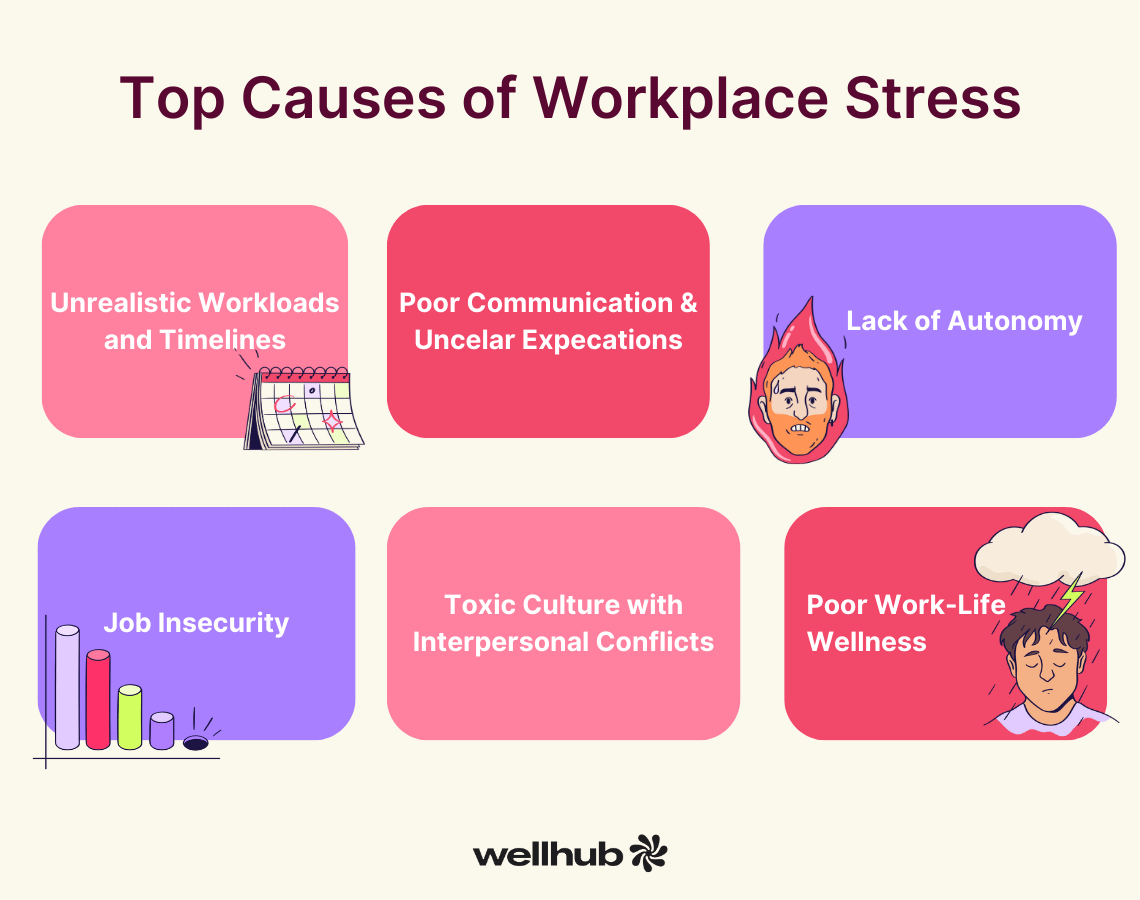
Unrealistic Workloads and Time Pressure
Stress is inevitable when employees are expected to do too much in too little time. Even high performers get burned out when faced with shrinking teams and tight deadlines. Day-to-day, unrealistic workloads and time pressure may lead to employees:
- Working late into the evening.
- Skipping lunch breaks.
- Rushing through tasks just to meet deadlines.
- Missing more deadlines and making more mistakes.
- Producing lower-quality work.
- Staying overtime more to catch up on work.
- Taking more mental health days off.
Over time, these patterns chip away at focus, creativity, and overall team morale. If nothing changes, the cycle can lead to:
- Presenteeism — employees being physically present at work but not fully productive
- Absenteeism — employees not being at work when they’re expected
- High turnover
Lack of Control or Autonomy
Employees are at their best when they have the freedom to make decisions, manage their own time, and approach work in a way that suits their strengths. Without this autonomy or control, employees can quickly feel frustrated and stressed. This often happens due to micromanagement, rigid workflows, or being excluded from decisions affecting their duties.
In day-to-day operations, you may notice managers hovering over every detail, requiring constant approvals, or rejecting ideas without discussion. Other warning signs of a lack of control or autonomy include:
- Employee reluctance to take initiative.
- Defensiveness when responding to feedback.
- More sick days or stress leave.
- Rising turnover rates as employees seek environments where they feel valued and trusted.
Over the long run, the employee may feel that leadership doesn’t trust them and that they’re not good enough at their job, leading to lower morale.
What’s driving workplace stress in 2025—and what you can do to combat it.
Poor Communication and Unclear Expectations
Clear, consistent communication is essential to safe and well-functioning workplaces. When it’s lacking, especially between leadership and frontline staff, employees can be left guessing about their roles, priorities, and responsibilities. This leads to miscommunication, wasted time and effort, increased anxiety, frustration, and ultimately, stress.
In practice, this can look like multiple team members unknowingly working on the same project, projects stalling due to missed information, a lack of performance benchmarks or feedback, or a chaotic, reactive culture where people jump from one task to the next with no sense of stability or consistency.
Over time, the organization develops a culture of “fire drills” where people spend more energy putting out preventable problems instead of building long-term success.
Toxic Culture or Interpersonal Conflict
A healthy organizational culture is built on respect, inclusion, and psychological safety. When these foundations are missing, toxicity fills the gap through gossip, favoritism, bullying, or exclusion — leading to stress. No amount of compensation, perks, or benefits can compensate for a culture that feels unsafe or hostile.
Signs of trouble may include passive-aggressive communication, team cliques, inconsistent treatment by managers, or a lack of accountability for harmful behavior. These behaviors create an atmosphere of mistrust where employees are afraid to speak their minds, making collaboration more difficult.
Job Insecurity and Organizational Change
Layoffs, restructures, and sudden business or task pivots can make employees uneasy about their future at the company. Even subtle signals, like leadership becoming less transparent, can create uncertainty. Signs that employees may feel uneasy about these signals include increased sick leave, rumor mills, and low participation in planning or meetings.
Poor Work-Life Wellness
Thanks to the ease of digital communication, work often continues even after people leave the office. This blurs the boundaries between work and personal time, leading to stress and resentment.
Warning signs that employees feel an organization offers poor work-life wellness include increased sick or stress leave days, low participation in planning or meetings, and higher turnover rates.
The Different Types of Workplace Stress: Positive and Negative
While “stress” is usually associated with negative consequences, some forms of stress are actually good. In fact, positive or manageable stress, or eustress, can be a motivating force. It can boost alertness, memory, and performance. As such, employees will have an easier time dealing with challenges, meeting deadlines, and pushing themselves creatively.
However, when stress becomes chronic or overwhelming, it turns into negative stress, or distress. This type leads to burnout, absenteeism, and long-term health issues. Distress happens when the pressure exceeds the person’s ability to control the situation that’s causing them stress. Examples include unclear expectations at work, a toxic work culture, workplace bullying, and a lack of support from managers.
Organizations must recognize the difference between the two. Positive stress can drive performance, but unchecked negative stress is a silent wellbeing and productivity killer.
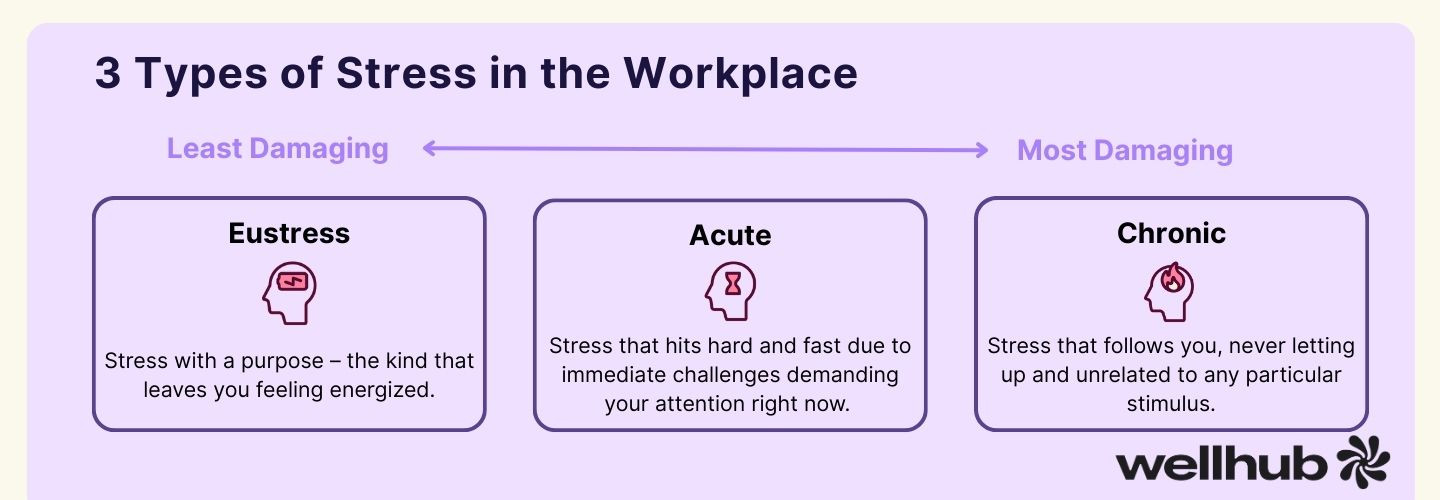
How Stress Impacts the Business Bottom Line (Statistics for 2025)
Besides chipping away at employees’ mental and physical health, stress can also negatively affect your company’s culture, morale, and bottom line. The latest U.S. data show workplace stress is directly eroding productivity, inflating benefit costs, and heightening retention and customer-experience risks—a bottom-line issue leaders can’t ignore.
- Lower productivity: Stress and poor mental health undermine focus, decision-making, and energy—showing up immediately in output and error rates. In APA’s recent U.S. surveys, large majorities reported work-related stress with negative effects on how well they perform. Meanwhile, U.S. employee engagement fell to a decade low in 2024 (about 31% engaged), a signal closely associated with productivity losses.
- More absenteeism and presenteeism: The national absence rate for full-time workers averaged roughly 3%+ in 2024. Mental-health-related leave has surged in recent years, and employers feel the productivity hit when people stay home—or show up but can’t perform at full capacity. Evidence from employer cost tools and research highlights substantial presenteeism losses tied to mental distress.
- Higher turnover: Burnout and stress increase intent to quit and actual separations, forcing costly backfills. In the Work Institute’s 2024 Retention Report, analysts estimate voluntary turnover alone costs U.S. employers “almost a trillion dollars” annually—before counting lost expertise and disrupted teams.
- Rising healthcare costs: Employer health premiums keep climbing—family coverage averaged $25,572 in 2024, up 7% in a year. Beyond premiums, the U.S. Surgeon General underscores how work factors (workload, control, safety) drive mental health outcomes that later surface as medical claims, disability, and lost work.
- Weakened customer experience: Customer outcomes fall when employees are depleted. A large U.S. study linking Glassdoor employee ratings to the American Customer Satisfaction Index found a strong statistical relationship between employee satisfaction and customer satisfaction. Harvard Business Review reiterates: better employee experience means better CX.
The World Health Organization estimates that anxiety and depression lead to 12 billion lost workdays each year — that’s a staggering $1 trillion in lost productivity worldwide. U.S. employers aren’t immune. Previous models estimate illness-related productivity losses in the hundreds of billions annually, with mental health inequities alone projected to cost the U.S. around $478 billion per year if left unaddressed.
The message is clear: even before factoring in global impacts, U.S. indicators like presenteeism, absenteeism, turnover, rising premiums, and customer experience risks all point to the same conclusion. Chronic stress isn’t just a wellbeing issue — it’s a core financial risk. And it deserves attention at the highest levels of leadership.
Dive deep into how stress impacts the workplace.
The Physical, Emotional, and Behavioral Effects of Workplace Stress
Stress isn’t just a feeling. It’s a physiological and psychological reaction with real physical, emotional, and behavioral symptoms.
Physical Health Symptoms
Stress affects nearly every system in the body, largely due to the overproduction of cortisol, the main stress hormone.
Over time, high levels of cortisol can cause a range of physical symptoms, including:
- Headaches and migraines
- Fatigue and low energy
- Muscle tension and body aches
- Sleep issues (insomnia or oversleeping)
- Gastrointestinal issues
- Elevated blood pressure
- Increased risk of chronic conditions, including cardiovascular disease
Emotional and Cognitive Impact
Workplace stress can also cause emotional and cognitive symptoms. These include:
- Anxiety and restlessness
- Depression and hopelessness
- Employee burnout and emotional exhaustion
- Irritability and mood swings
- Difficulty concentrating or making decisions
Employees experiencing these symptoms may struggle to perform effectively.
Behavioral Changes and Productivity Issues
When stress builds up, the way employees work and interact may change. Employees may pull away from coworkers, take more sick days, or show up but mentally check out. Some start procrastinating, while others rush through tasks just to get them off their plate, which can easily lead to mistakes.
Over time, creativity fades, productivity drops, and the team’s energy shifts from proactive problem-solving to simply reacting to the next crisis.
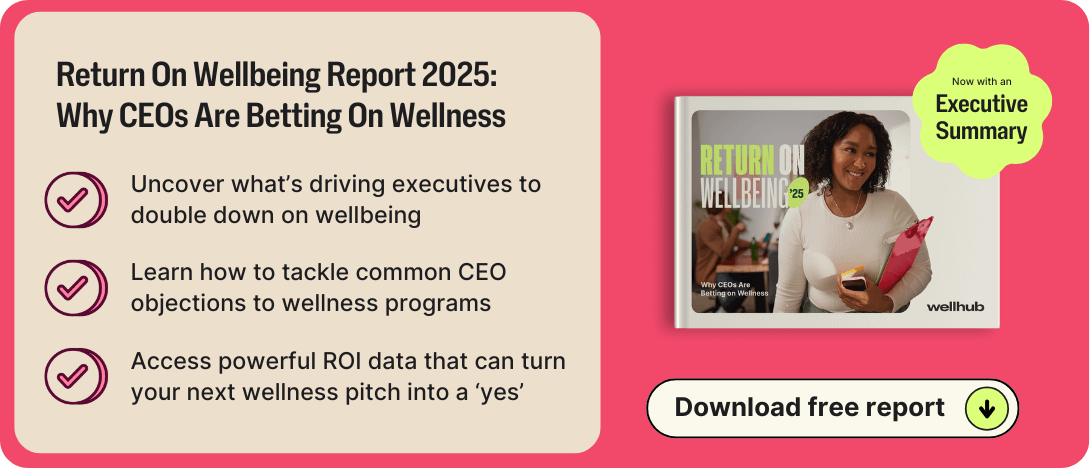
The Key Symptoms of Stress to Look for in Your Team
Proactively spotting stress in its early stages lets managers and HR leaders create a psychologically safe workplace—boosting performance, morale, and team cohesion.
- Sudden Drops in Performance or Quality of Work
- Reduced focus and motivation are common: according to the American Institute of Stress, 26% of U.S. workers report low energy or motivation, 21% experience decreased concentration, and 18% note reduced productivity.
- Burnout symptoms escalate across industries: 66% of U.S. employees now report experiencing burnout in 2025—marking one of the highest levels on record.
- In industries like healthcare, elevated stress, interpersonal conflict, and performance pressure are on the rise in 2025, signaling there degraded performance under psychological strain.
- Increased Irritability or Sensitivity to Feedback
- Irritability plagues many stressed employees: About 15% admit to feeling angry or short-tempered at work.
- Burnout amplifies negative moods: Reports include cynicism, irritability, and emotional drain—core signs of emotional depletion.
- Withdrawal from Team Interactions
- Quiet Cracking: As recently highlighted by Business Insider, employees are isolating emotionally—feeling trapped, fatigued, or unmotivated—signaling an urgent and silent breakdown in engagement.
- Social withdrawal is a recognized stress symptom, listed by OSHA to manifest behaviorally in workplaces (e.g., reduced participation, disengagement).
- Emotional disengagement erodes productivity and retention: Gallup notes that negative emotions like stress and exhaustion increasingly pull workers away from active engagement, which in turn heightens turnover risk.
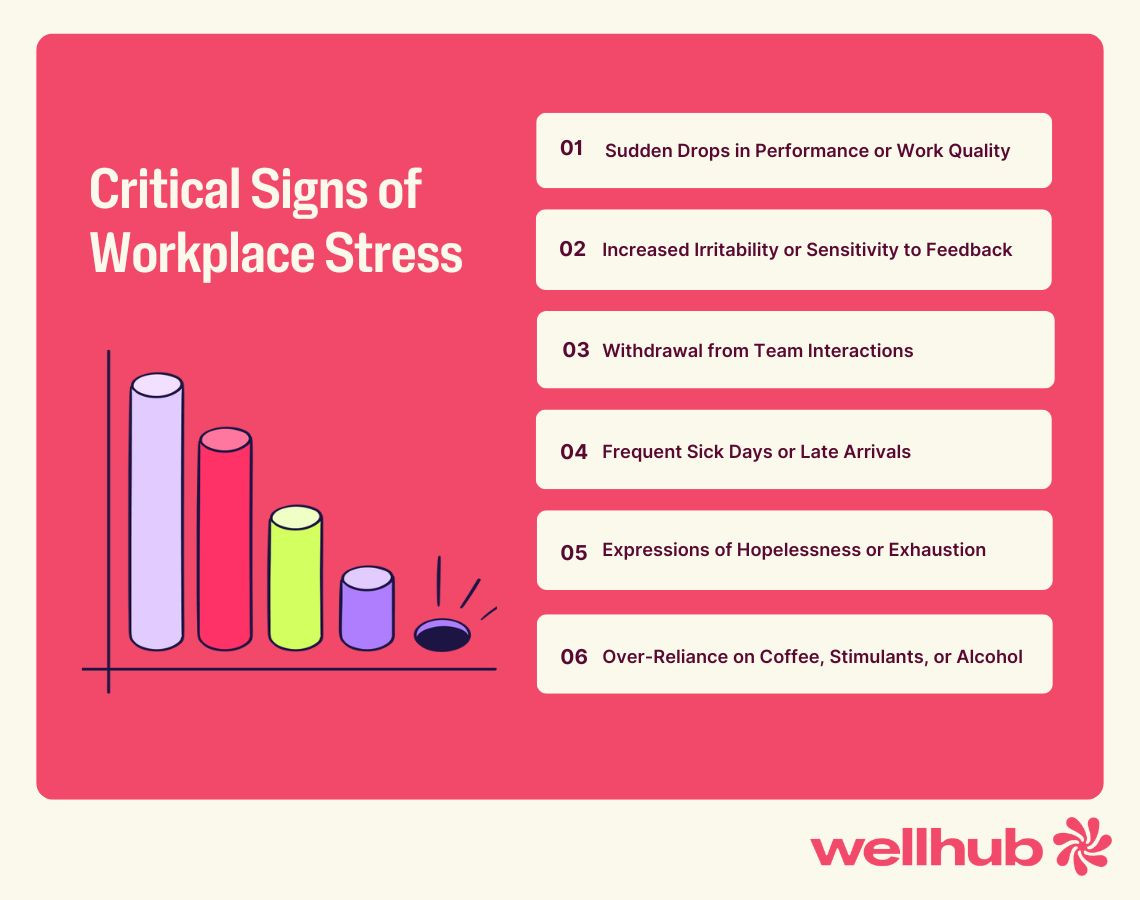
- Frequent Sick Days or Late Arrivals
- Absenteeism climbs under stress: Daily, approximately one million American workers miss work due to stress-related issues.
- Stress drives both absenteeism and presenteeism: Presenteeism—working while unwell—is even more costly, with on-the-job lost productivity estimated at around $255 per employee.
- Expressions of Hopelessness or Exhaustion
- Burnout prevalence is soaring: Forbes reports that in 2025, 66% of U.S. workers are experiencing burnout — the highest level recorded.
- Exhaustion and emotional collapse are evident: recent stories include individuals burning out so deeply they cry during their commute or suffer panic attacks—remarkable signs of emotional overload.
- Extreme exhaustion leaves physical traces: Frequent headaches, gut pain, and general fatigue are common among burned-out professionals—signs of pervasive exhaustion.
- Over-Reliance on Coffee, Stimulants, or Alcohol
- Dependence on coping aids: Academic studies show a link occupational stress to increased reliance on alcohol and other substances.
- Turning to comforts: Burned-out individuals often seek quick relief through food, alcohol, or similar comforts as emotional crutches.
Stress doesn’t just “show up” quietly—it undermines performance, morale, and mental health in observable ways. Managers who notice these signs—especially when multiple appear together—should treat them as red flags, not just momentary dips.
These are the10 signs of stress HR shouldspot before it's too late.
How U.S. Companies Are Managing Workplace Stress: Real Stories and Evidence
- Aflac – Holistic Wellness Integration with Wellhub
Aflac launched Wellhub in 2022, offering employees access to a unified platform covering physical activity, mental health, sleep, nutrition, and family-focused content. Initial uptake was 15%, which jumped as they introduced Wellhub+ in 2023, fully covering costs for employees. The campaign—featuring posters, wellness champion meetings, and visible executive endorsement—boosted active usage to 45%. The program became deeply embedded in the culture, even influencing retention and new hiring.
From Medications to Movement: How Aflac Sparked a Culture Shift With Wellhub
- Taylor-Based Companies – “Booster Breaks”
The “Booster Break” model encourages brief, structured group breaks—10–15 minutes of guided physical or social activity—embedded throughout the workday Wikipedia. Studies show they can reduce sedentary behavior, foster social support, boost health-promoting habits, and enhance productivity.
- Nordic-Style Total Worker Health Programs
Following the Total Worker Health framework, companies such as Caterpillar, FedEx, Dow Chemical, and Perdue Farms have integrated occupational safety with health promotion. These efforts tighten the link between workplace safety and wellness, yielding documented improvements in employee health outcomes and organizational ROI.
- Mindfulness at IBM and Deloitte
- IBM offers weekly mindfulness training—yoga, meditation, cognitive techniques—that has improved mental clarity and employee engagement while lowering stress-related absenteeism and enhancing retention.
- Deloitte, incorporating mindfulness and broader mental health initiatives into its culture, reports a 30% lift in retention among participants .
- Northwell Health — Mental and Physical Boosts
Northwell Health, New York’s largest private employer with over 80,000 staff, partnered with Wellhub in late 2023 to offer its workforce a breadth of wellness options—from top-tier gyms like Lifetime and OrangeTheory to digital apps such as Headspace and MyFitnessPal. Since launching Wellhub, gym attendance increased by about 11% monthly and wellness app usage rose by roughly 8% monthly.
How to Prevent and Reduce Workplace Stress
Addressing workplace stress can be daunting, especially when it’s rooted in company culture. Luckily, change doesn’t have to happen overnight. By taking small, consistent steps, organizations can build a supportive, responsive environment where employees feel valued and equipped to thrive. Here’s how to start.
Encourage Open Communication
A culture of openness is one of the most effective ways to mitigate workplace stress. The more transparent and non-judgmental the communication is, the more employees feel seen. This, in turn, removes the stigma around asking for help.
Here’s how to encourage open communication:
- Normalize conversations about mental health so employees know it’s safe to speak without fear of judgment.
- Train managers in emotional intelligence and active listening so they can respond with empathy rather than defensiveness.
- Provide confidential channels for employees to share concerns, such as one-on-one meetings. That way, sensitive issues can be handled discreetly.
Improve Workload Management
Stress often spikes when workloads are unbalanced or deadlines are unrealistic. Here are some for improving workload management:
- Use time-tracking data to redistribute work more fairly.
- Set realistic deadlines.
- Actively discourage the “always on” mentality that blurs the line between personal and work life.
- Protect time for rest by discouraging employees from taking their paid time off. Proactively protect lunch breaks from meetings by assigning a specific time block for lunch.
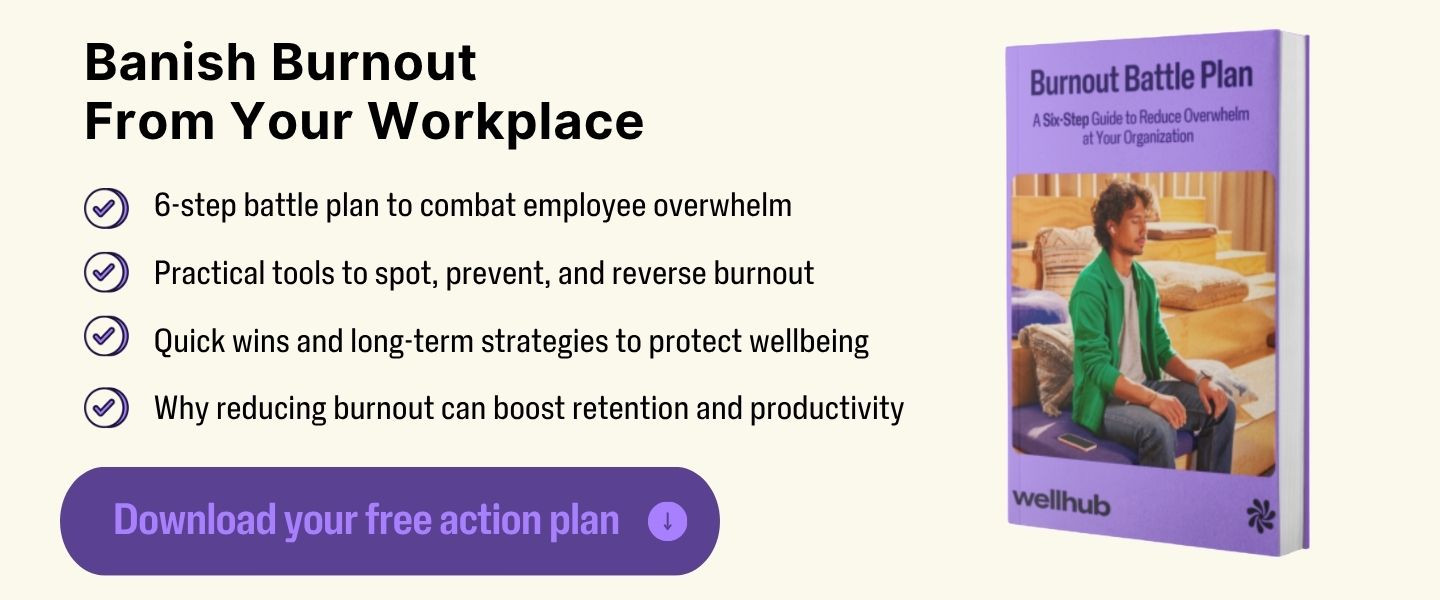
Invest in Employee Wellbeing Programs
Employee wellbeing programs give employees access to a centralized hub of wellbeing resources, such as fitness and mindfulness apps, sleep improvement tools, nutrition planning, and emotional wellbeing support. By addressing multiple health dimensions, these programs help employees build resilience, maintain balance, and perform at peak capacity.
Offer Flexibility and Work-Life Support
Flexibility is one of the best ways to prevent burnout. The more autonomy employees have over their personal and professional commitments, the more likely they will stay engaged, loyal, and motivated.
Whenever possible, offer hybrid or remote work arrangements and let employees structure their schedules around their natural energy peaks. Also consider providing tangible support such as parental leave, childcare subsidies, and flexible scheduling for those with caregiving responsibilities.
Train Managers to Support Mental Wellbeing
Managers are often the first to see when employees are struggling and the impact of stress at the workplace. But without proper training, they may not know how to respond in the right way. Here’s what you can do to help them support mental health:
- Provide mental health first aid training so they can identify warning signs and provide immediate support.
- Give them tools for managing workloads fairly.
- Coach them on how to give feedback with clarity and compassion.
Support Your Employees and Reduce Stress With a Wellbeing Program
Workplace stress comes from many directions—unrealistic workloads, poor communication, lack of autonomy, toxic culture, and blurred work-life boundaries. Left unaddressed, these issues drain productivity, increase absenteeism, and fuel turnover.
A strategic wellbeing program helps employees build resilience, manage stress, and stay engaged. Platforms like Wellhub give people access to fitness classes, therapy apps, meditation tools, and more—all in one place. This support helps improve focus, reduce burnout, and strengthen team moral: Hence why 56% of CEOs invest in wellness programs to enhance employee productivity and performance.
Speak with a Wellhub Wellbeing Specialist to create a healthier, more focused workforce.

Company healthcare costs drop by up to 35% with Wellhub*
See how we can help you reduce your healthcare spending.
[*] Based on proprietary research comparing healthcare costs of active Wellhub users to non-users.
Category
Share

The Wellhub Editorial Team empowers HR leaders to support worker wellbeing. Our original research, trend analyses, and helpful how-tos provide the tools they need to improve workforce wellness in today's fast-shifting professional landscape.
Subscribe
Our weekly newsletter is your source of education and inspiration to help you create a corporate wellness program that actually matters.
Subscribe
Our weekly newsletter is your source of education and inspiration to help you create a corporate wellness program that actually matters.
You May Also Like

FSA vs. HSA Strategy for HR Leaders | Wellhub
Compare FSA vs HSA rules, tax advantages, eligibility, and rollover differences to help employees choose the right account and avoid costly compliance issues.

Employee Wellness Programs: Key Components for Success | Wellhub
Transform your workplace wellness strategy by integrating physical, mental, financial, and social wellbeing into a comprehensive wellness program that works

Benefits Strategy Roadmap: Pull and Retain Top Talent | Wellhub
Support wellbeing, reduce turnover, and maximize ROI with a benefits strategy built for today’s workforce—not yesterday’s spreadsheet.